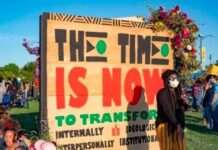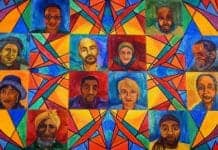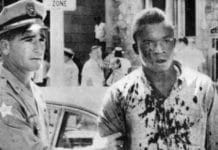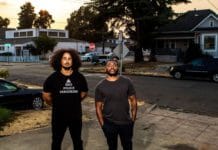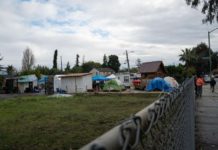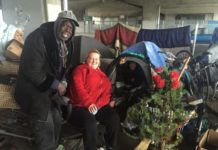Review by Kheven LaGrone

Hot gossip sells. Under the guise of “meaningful dialogue,” talk show hosts titillate with provocative, yet shallow, questions like: How could such a monster (referring to the male celebrity) be created? Does she love herself? Does she love her body? Will she go back to him?
For African-Americans, the following questions might also arise: Do Black men hate Black women? Do Black women hate themselves?

If the couples were same-gender, the discussions would be more radical. What if both the victim and the abuser were women? What if both were men?
C.D. Kirven’s video short (14 min.) titled “The Dark Side of the Rainbow” helps start that radical discussion. It is a factual video about same-gender domestic violence.
“The Dark Side of the Rainbow” presents domestic violence outside of the usual discussion of male-female power disparity. Instead, we would have to focus on love and trust. Love is trust. Home is a safe space. Domestic violence violates both trust and home.
Texas-born C.D. Kirven cleverly captured “The Dark Side of the Rainbow” on a cell phone. What medium better captures the urgency and terror of being abused in one’s own home and by someone loved and trusted? While being domestically abused, one cannot run to one’s partner for solace. One cannot escape home for safety. Love and home become places of fear and danger.
In an e-mail, Kirven, an African-American lesbian, tells me that she chose the title because “we think the rainbow – the gay symbol – is all about fun and parties, but there is also a dark side that no one likes to talk about, such as abuse or racism within the GLBT community.”
According to Kirven, domestic violence is “deadly to the GLBT community.” She believes that a same-gender loving person may be denied emergency services and protective orders due to homophobia. The person may feel trapped into his or her violent relationship and “so they go back to the abuse and die.”
Kirven also believes that same-gender-loving African-Americans are less willing to seek help or support than white same-gender-loving couples.
Thus, culture-based examinations might be useful. For example, African-American men are often taught that our value is mainly in our physical prowess, such as fighting or sports. So to be an African-American man beaten up by another man – a gay man nonetheless – could be more than just embarrassing, it could be invalidating.
When Alice Walker broached the topic of domestic violence in the African-American community in her novel “The Color Purple,” some critics accused her of Black male-bashing and attacking the Black family and community. Since the novel’s protagonist was a lesbian, some “accused” Walker of “promoting” lesbianism as the “panacea.”
The strength of “The Dark Side of the Rainbow” is in its “voids.” The video does not analyze same-gender domestic violence. It simply brings the subject out in the open for discussion.
Nor does the video offer simplistic solutions. Domestic violence, homosexual or heterosexual, African-American or not, is much too complex. Each couple or individual has to find out what works for them. Besides, what’s abuse for one couple may not be abuse for another couple.
Also, it should be noted that “The Dark Side of the Rainbow” is not the videographer’s personal story. The audience is not directed to sympathize with the storyteller or passively follow the storyteller’s journey. This is effective here because it allows each viewer to come to his or her own conclusion.
However, Kirven confided in her e-mail that as she was finishing the video, she found herself experiencing domestic violence for the first time. She writes “I’ve only shared this with a couple of people but I’ve been going through a domestic violence situation. We are no longer together but it happened as I was finishing this film. It gave me a greater appreciation of this issue. It moved me from being a crusader for those victims without a voice. [The video] became personal.”
When I asked why she had not spoken publicly before, she answered: “I feel hurt … ashamed because I thought she loved me but if she could hit me then she really didn’t. I’m still coming to terms with that. I still love her but also have to deal with the pain of its ending and the violence.”
Kirven’s using the cell phone for her medium added a feeling of honesty and vulnerability to “The Dark Side of the Rainbow.” By capturing this video on cell phone, we do not get a pretty polished video. There were no rehearsals or re-takes.
The video is short and to the point.
However, the editing of “The Dark Side of the Rainbow” distracted from the video rather than enhanced it. Written messages appear and disappear too quickly. At times, the wording appears when imagery would have been more impacting. There were moments in the video when the visuals were abruptly interrupted by the wording. The audience is given too much to read and too little time to read it; or the audience is given too little time to think about a message. This is especially problematic in a “message movie.”
“The Dark Side of the Rainbow” is now part of Chicago’s Center of Halsted’s same sex abuse training. The video has screened at the Dallas Resource Center, the San Diego Black Film Festival and is a finalist in the USA Film Festival. It will be screened at the Reno Gay and Lesbian Film Festival and the Austin LBGT Film Festival.
(The video will also be screened at Oakland’s GLBT Film Festival in August 2009. I was going to wait until then to write this essay, but considering the controversy about Chris Brown and Rihanna, I thought now might be a better time to review it.)
Kirven is currently raising money for the first GLBT emergency domestic violence shelter “so that no one else has to die because of the dark side of the rainbow. We have to have a conversation about this and this is not only a heterosexual problem.”
Kheven LaGrone is the editor of “Alice Walker’s ‘The Color Purple,'” a collection of literary criticism on the controversial novel. He can be reached at kheven@aol.com.

 Store
Store



